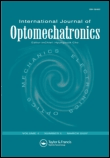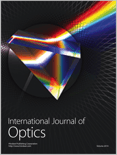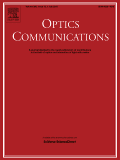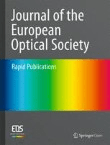
International Journal of Optomechatronics
Scope & Guideline
Connecting disciplines for groundbreaking advancements.
Introduction
Aims and Scopes
- Optomechanical Systems Design and Control:
Research in this area emphasizes the design and control methodologies for optomechanical systems, including MEMS devices and advanced optical components, aimed at improving performance in various applications. - Optical Sensing and Imaging Techniques:
This scope includes the development and application of advanced optical sensing and imaging techniques, such as wavefront sensing, fluorescence imaging, and optical coherence tomography, to enhance measurement accuracy and resolution. - Nanophotonics and Metamaterials:
The journal explores the design and application of nanophotonic devices and metamaterials, focusing on their unique optical properties for applications in sensing, imaging, and communication technologies. - Applications in Biomedical Engineering:
A significant focus is placed on the application of optomechatronic principles in biomedical engineering, including tissue imaging, drug delivery systems, and medical diagnostics, promoting advancements in healthcare technologies. - Innovative Fabrication Techniques:
Research on novel fabrication techniques, such as 3D printing and nano-structuring, is emphasized to create advanced optomechanical components with enhanced functionalities and reduced manufacturing costs.
Trending and Emerging
- Artificial Intelligence and Machine Learning Applications:
The integration of AI and machine learning techniques in optomechanics is on the rise, particularly for improving sensor performance and automating complex systems, showcasing the journal's commitment to modern technological advancements. - MEMS Technology Innovations:
There is an increased emphasis on MEMS (Micro-Electro-Mechanical Systems) technologies, particularly in applications like scanning mirrors and sensors, reflecting their growing importance in various high-tech applications such as robotics and biomedical devices. - Bio-inspired Optics and Photonics:
Research focusing on bio-inspired designs for optics and photonics is gaining traction, highlighting the potential for nature-inspired solutions to enhance optical systems and improve efficiency in various applications. - Advanced Metamaterial Research:
The exploration of metamaterials, particularly for applications in EMI shielding and sensing, is trending, indicating a strong interest in developing materials with tailored optical properties for next-generation technologies. - Optofluidics and Microfluidic Systems:
The application of optofluidics for sorting and manipulating microparticles is emerging, reflecting a growing interest in combining optical techniques with fluid dynamics for innovative solutions in biomedical and environmental applications.
Declining or Waning
- Traditional Optical Communication Systems:
The focus on conventional optical communication systems has waned, likely due to the rapid evolution of integrated photonic technologies and the emergence of novel communication paradigms like quantum communication. - Basic Optical Theories without Practical Application:
There has been a noticeable decline in papers that only address fundamental optical theories without a clear application, as the journal increasingly favors studies that demonstrate practical implementations and technological relevance. - Single-Disciplinary Studies:
Research papers that solely concentrate on optics or mechanics in isolation are becoming less common, reflecting a trend towards interdisciplinary studies that integrate multiple fields of expertise.
Similar Journals

Optics Continuum
Pioneering Discoveries in Light and MaterialsOptics Continuum, published by Optica Publishing Group, is a pioneering open access journal dedicated to advancing the field of optics and photonics. Since its inception in 2022, this journal seeks to provide a vital platform for the dissemination of groundbreaking research and innovative developments across several interconnected domains, including electrical and electronic engineering, atomic and molecular physics, and material sciences focused on electronic, optical, and magnetic materials. With impressive rankings in Scopus—placed #384 in Electrical and Electronic Engineering and #109 in Atomic and Molecular Physics—the journal aims to engage a diverse readership comprised of researchers, professionals, and students, promoting collaboration and knowledge exchange. The journal's open access model ensures that cutting-edge research is readily available to all, nurturing an inclusive academic environment. For those interested in staying at the forefront of optics research, Optics Continuum is an essential resource that continuously enriches the global scientific community.

Biomedical Optics Express
Illuminating the Future of Biomedical ResearchBiomedical Optics Express, published by the prestigious Optica Publishing Group, is an open-access journal that has been at the forefront of the field of biomedical optics since its inception in 2011. With an ISSN of 2156-7085, this journal has established itself as a premier platform for disseminating high-quality research that spans an array of topics in atomic and molecular physics, optics, and biotechnology. As a testament to its scholarly impact, it is currently ranked in the Q1 category for both Atomic and Molecular Physics and Biotechnology, reflecting its commitment to excellence within these disciplines. The journal features cutting-edge articles that foster innovation and collaboration among researchers, professionals, and students who are passionate about applying optical technologies to solve pressing challenges in medicine and biology. Based in the United States, Biomedical Optics Express continues to shape the future of optical science and its applications, inviting contributions that inspire and drive forward the boundaries of knowledge.

International Journal of Optics
Advancing Knowledge Through LightWelcome to the International Journal of Optics, a distinguished publication dedicated to advancing the field of optics and its interdisciplinary applications. Published by HINDAWI LTD, this open-access journal has been pivotal in fostering knowledge since its inception in 2009. With a robust focus on atomic and molecular physics as well as electronic, optical, and magnetic materials, the journal has carved its niche within Q3 quartile rankings in these categories for 2023, signifying its growing impact and relevance in the scientific community. Researchers and professionals will find a rich repository of innovative and cutting-edge research articles that not only address fundamental aspects of optics but also explore practical applications across various domains. The journal's aim is to promote high-quality research dissemination, enhancing collaboration among scientists and ensuring that pivotal findings reach a global audience. Join us in exploring the dynamic world of optics—where your contributions help shape the future of science.

OPTICS COMMUNICATIONS
Pioneering Insights in Optics and PhotonicsOptics Communications, published by Elsevier, is a prestigious international journal that focuses on the dynamically evolving fields of optics and photonics. With its ISSN 0030-4018 and E-ISSN 1873-0310, this journal has made significant contributions to the fields of Atomic and Molecular Physics, Electrical and Electronic Engineering, Electronic, Optical and Magnetic Materials, and Physical and Theoretical Chemistry, consistently ranking in the Q2 quartile across these categories for 2023. The journal, based in the Netherlands, is recognized for its rigorous peer-review process and aims to publish high-quality research articles that advance knowledge and applications in optical communication technologies. Although it operates under a subscription model, the insightful research published here plays an essential role in informing the work of researchers, professionals, and students alike. With a history dating back to 1969 and spanning well into 2025, Optics Communications remains a crucial resource for cutting-edge developments in optics, catering to a global audience dedicated to innovation in this pivotal science.

Optica Pura y Aplicada
Advancing the Frontiers of Optical ScienceOptica Pura y Aplicada, published by the SOC ESPANOLA OPTICA, stands as a vital platform for the dissemination of cutting-edge research in the fields of Atomic and Molecular Physics, Optics, and related engineering disciplines. Established in Spain, this journal aims to foster the advancement of knowledge in optical science and technology by providing a rigorous peer-reviewed publication outlet for scholars, researchers, and practitioners. Despite being categorized in the Q4 quartile across multiple domains, including Engineering and Materials Science, the journal remains committed to contributing meaningful insights and advancements within its scope. With an ISSN of 0030-3917 and an E-ISSN of 2171-8814, the journal effectively reaches a global audience eager to explore innovative applications and theoretical developments in optics and materials science. Researchers and professionals alike will find in Optica Pura y Aplicada a valuable resource for enriching their understanding and practices in an ever-evolving field, fostering collaborations and promoting research growth until its converged conclusion in 2024.

Optics is a pioneering open access journal published by MDPI, dedicated to advancing the field of optics and photonics. Since its inception in 2020, the journal has fostered the dissemination of high-quality research and innovative developments in optical sciences, contributing significantly to its community of researchers, professionals, and students in Switzerland and beyond. With an impact factor reflective of its growing prominence, Optics strives to address a diverse scope, encompassing atomic and molecular physics, electronic materials, and broader topics in physics and astronomy. The journal's commitment to open access ensures that cutting-edge research is freely available, promoting collaboration and knowledge-sharing across disciplines. As of 2023, it holds a Q4 ranking in several categories, including Atomic and Molecular Physics, and Optics, which illustrates its evolving role in the academic landscape, positioning it as a valuable resource for those seeking to explore the frontiers of optical technology and its applications.

OSA Continuum
Pioneering Insights in Optical and Material SciencesOSA Continuum, published by the Optica Publishing Group, is a distinguished open access journal dedicated to advancing research in the realms of Atomic and Molecular Physics, Optics, and Electronic and Electrical Engineering. Since its inception in 2018, this journal has rapidly positioned itself as a significant platform for disseminating cutting-edge findings, achieving impressive Scopus rankings with a 61st percentile in Electrical and Electronic Engineering and 57th in Atomic and Molecular Physics. Based in the United States, the journal not only promotes scholarly dialogue among researchers and professionals but also plays a crucial role in bridging theoretical advances with practical applications in optical and material sciences. Its open access format ensures broader visibility and accessibility of research outputs, fostering innovation and collaboration across disciplines. With its ongoing commitment to excellence, OSA Continuum is crucial for anyone involved in these dynamic fields.

Journal of the European Optical Society-Rapid Publications
Pioneering Quick Communication in Optical SciencesJournal of the European Optical Society-Rapid Publications, with ISSN 1990-2573 and published by EDP Sciences S A, is a premier open access journal dedicated to advancing the field of optics and photonics since its inception in 2006. Based in France, this journal serves as a vibrant platform for researchers, professionals, and students to disseminate their findings quickly and efficiently. Achieving a commendable Q3 ranking in Atomic and Molecular Physics and Optics (2023), it reflects a growing impact within the scientific community, despite currently holding a 33rd percentile rank among similar publications in the realm of Physics and Astronomy. The journal fosters an environment of rapid communication and collaboration, making it an invaluable resource for those interested in the latest developments and innovations in optical sciences. With open access ensuring broad visibility for all published work, the Journal of the European Optical Society-Rapid Publications is positioned as a key contributor to enhancing the understanding and application of optical technologies.

Korean Journal of Optics and Photonics
Unveiling the Potential of Light TechnologiesKorean Journal of Optics and Photonics is a premier publication dedicated to advancing knowledge in the rapidly evolving fields of optics and photonics. Published by the esteemed Optical Society of Korea, this journal serves as a vital platform for researchers, professionals, and students seeking to disseminate their findings and innovations in areas such as optical engineering, photonics technologies, and application developments. Although the journal does not operate under an Open Access model, it is committed to high-quality peer-reviewed research that contributes significantly to both theoretical and practical advancements in the field. With an increasing focus on interdisciplinary research, the Korean Journal of Optics and Photonics is poised to play a crucial role in fostering collaboration and driving the global conversation on light science and technology. The journal's ISSN is 1225-6285 and it also carries the E-ISSN 2287-321X, ensuring its availability to a wide readership.

Progress in Electromagnetics Research-PIER
Exploring the Depths of Electromagnetic PhenomenaProgress in Electromagnetics Research-PIER, published by EMW PUBLISHING, is an esteemed academic journal that stands at the forefront of the fields of Condensed Matter Physics, Electrical and Electronic Engineering, and Radiation. With an impressive impact factor reflected in its Q1 quartile rankings across these disciplines, PIER serves as a critical platform for disseminating high-quality research findings and advancements from 2000 onwards, with the latest contributions expected through 2024. The journal's commitment to excellence is evident as it holds prominent positions in Scopus rankings, including a remarkable 95th percentile in the field of Radiation. Researchers, professionals, and students will find PIER invaluable for accessing cutting-edge topics and methodologies that push the boundaries of electromagnetics research. For facile access, the journal is published in both ISSN (1070-4698) and E-ISSN (1559-8985) formats, ensuring that vital knowledge is readily available to its audience.